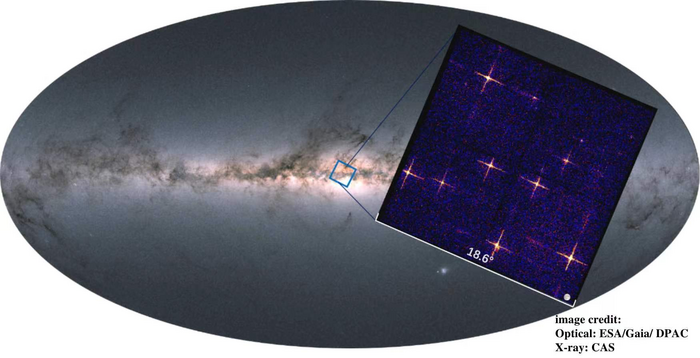EP-WXT Pathfinder, the experimental version of a module that will eventually be part of the wide-field X-ray telescope (WXT) aboard the astronomical satellite Einstein Probe (EP), released its first results Aug. 27 from an earlier test flight. These include an 800-second X-ray time-lapse photograph of a region of the Galactic center, a dense area at the core of our home galaxy, the Milky Way.

Credit: CAS/ESA/Gaia/DPAC
EP-WXT Pathfinder, the experimental version of a module that will eventually be part of the wide-field X-ray telescope (WXT) aboard the astronomical satellite Einstein Probe (EP), released its first results Aug. 27 from an earlier test flight. These include an 800-second X-ray time-lapse photograph of a region of the Galactic center, a dense area at the core of our home galaxy, the Milky Way.
These mark the first wide-field X-ray snapshots of our universe available to the public so far, captured by the first truly wide-field X-ray focusing imaging telescope ever flown in space.
The results were reported by scientists from the Chinese Academy of Sciences (CAS) at the Second China Space Science Assembly held in Taiyuan, China.
Since the first detection of X-ray signals from the depths of the universe 60 years ago, no wide-field X-ray focusing telescope has been available for X-ray surveys and monitoring until Pathfinder.
The Pathfinder was sent into orbit to verify the module’s in-orbit performance. The experimental journey is meant to pave the way for the future in-orbit science operation of EP as it makes observations in the soft X-ray waveband.
EP will explore open questions in time-domain astrophysics through observation of transients. The mission is sponsored by CAS in cooperation with the European Space Agency (ESA) and the Max Planck Institute for Extraterrestrial Physics and is expected to fly by the end of 2023.
The WXT test module covers a field of view up to 340 square degrees (18.6°×18.6°) wide, which makes it the first truly wide-field X-ray focusing imaging telescope. X-ray imaging by bending light rays (focusing) is notoriously difficult due to the high energy of X-ray photons; and it is even more difficult to obtain clear images from a wide field of view. Thanks to a state-of-the-art technology called lobster-eye micropore optics, the test module boasts a field of view at least 100 times those of other focusing X-ray imagers. The complete WXT to fly aboard EP will be composed of 12 such identical modules, covering a field of view up to 3,600 square degrees wide.
During the test flight, Pathfinder conducted a total of four days of in-orbit experimental observations and obtained authentic X-ray spectra and images based on real measurements.
The key components of Pathfinder include the X-ray imaging mirror assembly, which features an array of 36 micropore lobster-eye plates and a focal-plane detector composed of four sets of large-format imaging sensors.
Even though these results are still preliminary and extensive data processing must be done, the test flight demonstrates that even a one-shot observation can cover X-ray sources from all directions within the observed patch of sky, including stellar-mass black holes and neutron stars. The observation also captured the brightening of X-rays from a binary system containing a neutron star. The data from these observations provide information about how X-ray radiation from such celestial bodies changes over time, as well as the X-ray spectra of these celestial bodies. The images and spectra resulting from the test observations are highly consistent with simulations.
The instrument also targeted a number of other X-ray sources, including the Large Magellanic Cloud (LMC), one of our neighboring galaxies. The results demonstrate that even a one-shot observation can cover the whole of this galaxy, detecting multiple X-ray sources, including black holes, neutron stars and supernova remnants. The instrument’s clear imaging of a distant quasar, 3C 382, at a distance of 810 million light-years, reveals its capacity to detect relatively faint X-ray sources. In its future observations, the imager is expected to effectively monitor the X-ray variability of celestial bodies and discover new transient sources.
According to Dr. YUAN Weimin, principal investigator (PI) of the EP mission and researcher at the National Astronomical Observatories of the Chinese Academy of Sciences (NAOC), initial results show that “the instrument operates smoothly” and meets EP WXT module requirements. “It’s exciting to see the decade-long effort bearing its first fruit,” he smiled.
Other researchers involved with the EP mission were also satisfied.
Dr. ZHANG Chen, PI of the WXT mirror assembly, said the results promise “abundant, high-quality data” after the probe is launched.
Prof. Paul O’Brien, ESA-appointed scientist for the EP mission and researcher at the University of Leicester, said the results are “really impressive.”
“We have been waiting for a true wide-field, soft X-ray imager for many decades, so it is wonderful to see the WXT test module in flight on EP-WXT Pathfinder,” said Prof. Richard Willingale, Prof. O’Brien’s colleague at the University of Leicester.




